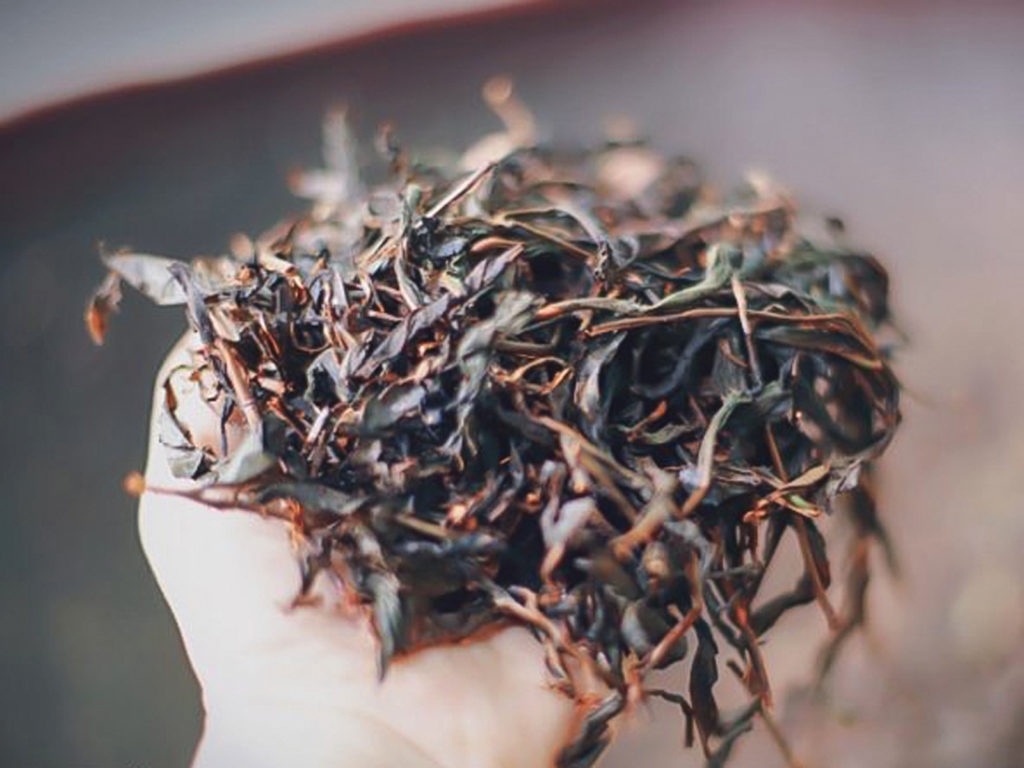
Black tea, known to the Chinese as red tea, is the most common product of the tea bush, produced by encouraging freshly picked tea leaves to darken with large amount of cellular oxidation. Black tea is consumed all over the world, although it is the least popular style of tea in China.
The Different Styles of Black Tea
There are three distinct styles of producing black tea in China.
- Zhen Shan Xiao Zhong Hong Cha 正山小种
The original style of black tea from the Wu Yi mountains. Higher grades are comprised of broad open leaves and are roasted and dried by the heat an earthen oven wood burning fire. This oven is thought to have evolved, or at least is similar to the oven used to dry tobacco. This style of processing tea may intentionally expose the drying leaves to the smoke of horse tail pine trees during drying to impart a prominent tarry character that its teas are known for. This was not the intention in the beginning. - Gong Fu Hong Cha 功夫红茶
Sometimes called to as “Congou” black tea by western sources. “Congou” or “Gong Fu” is a reference to patience and skill required by its manufacturing process. This is the most widespread style of black tea produced in China. Both Keemun and Dian Hong black teas are made by the Gong Fu method. Traditionally, this method requires hand picking of whole buds and leaves. After a fair amount of delicate hand processing higher quality examples of Gong Fu Hong Cha are dried over charcoal while electric dryers may be used to finish lesser grades. Good Gong Fu style black tea will retain recognizable leaf shape, although it is not uncommon for lower grades to be chopped like Hong Sui Cha. - Hong Sui Cha 红碎茶
Broken Black Tea made specifically for foreign consumption. This type of tea is mass produced with modern machinery and is sorted in accordance with the grading system used by the international market.
Regions Producing Black Tea
The range in quality is greater in black tea than any other – most is grown and mechanically harvested on a huge scale in places like India, Sri Lanka and Kenya. China’s main black tea producing regions; the province of Yunnan, Anhui, and the legendary Lapsang farm in Tong Mu Village of the Wu Yi Mountains are finally being acknowledged in China as genuinely top quality teas in their own right. They are hand-picked and laboriously hand processed, achieving the exact amount of oxidation (exposure to air at the critical stage in processing, which is also known as fermentation) to produce the unique rich, robust black tea flavor and beautiful amber to red color.
Other Types of Black Tea and Their Regions
There is a direct chain of inheritance of black tea making culture, starting with the Zhen Shan Xiao Zhong of Tong Mu Village in Wu Yi Shan in Northern Fujian, to Qimen in Anhui, and Dian Hong in Yunnan.
Qimen
The origins of Qimen (Keemun) is also controversial. The popular story is that Yu Gan Cheng started Qimen production in 1875 or 1876. He had been an official in Fujian, perhaps had spent time in Wu Yi Shan, and moved to the Qimen area to try his hand at black tea making. In 1916, however, a Department of Agriculture magazine gave the credit to Hu Yuan Long from Qimen. Which ever is true, the date is not questioned. The Huang Shan area already well known for green tea and tea making techniques that emerged into the roots of modern tea making after the radical change in the Ming Dynasty when cakes were banned, produced a flavorful bush called Zhu Ye Zhang. This was the bush used to become the source of Qimen tea, the only black tea to become a famous Chinese tea. Sweet and spicy quality led it to become a favorite of Queen Victoria.
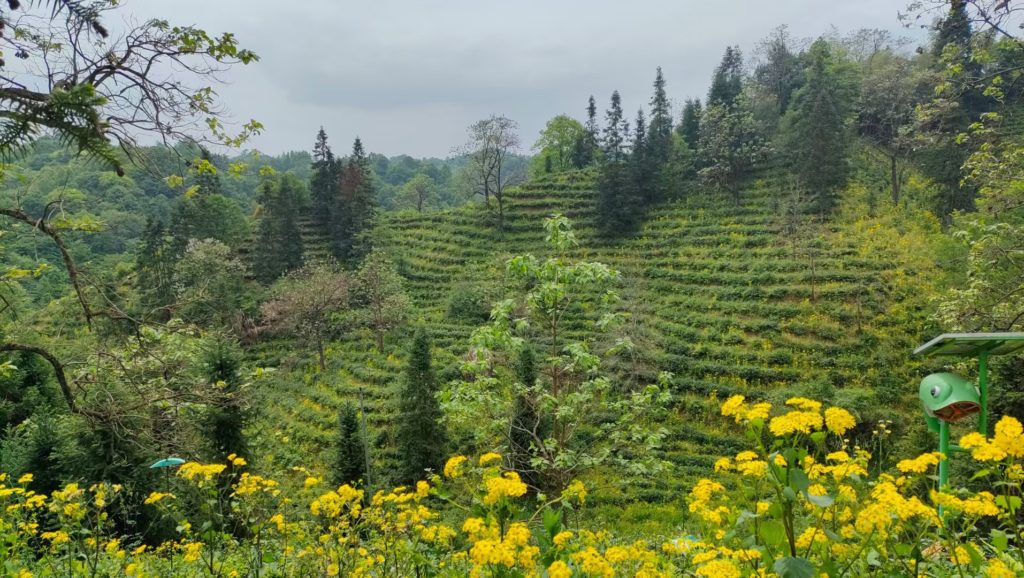
Yunnan
Finally in 1938, Feng Shao Qiu came from Qimen to work for the newly formed Yunnan China Tea Trading Company and along with Fan He Jun, he evaluated Menhai and Feng Qing for the source of tea leaves to make black tea from. They settled on the Feng Qing area and in 1939 opened the Yun Hong factory there. In 1940 they changed the name to Dian Hong. The sweetness and beautiful color of this tea is renowned and still provides the key tea in the Asian Lipton blend. In 1989 the English provided the factory with its CTC machinery, prior to that the tea was made in the traditional way.
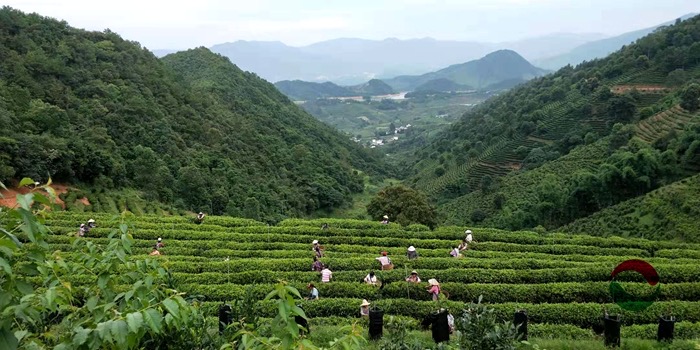
It should be noted that Robert Fortune, the famous Scottish tea spy for the English, that penetrated China dressed as Chinese, traveled to Wu Yi Shan in a sedan chair. He brought tea seeds and cuttings which were planned in the Darjeeling area, but he did not learn the deepest secrets of tea making. It took the English 20 years to get a drinkable crop. Still today the Chinese black teas are very different from the international black teas. Chinese black tea has a remarkable sweetness, and are very unlikely to become bitter. Black tea drinking, in the last few years, has increased in China as modernity exposes the Chinese population to a group of its own teas that had only recently seen appreciation on the international market.
The Colorful History of Black Tea
The question of when black tea was invented remains much debated amongst tea scholars. All we can surely say is that by the 16th century black tea was appearing in Chinese tea markets. It’s clear though, if one was to search for the real origin of black tea production, you’d have to go back a little further.
Some people might argue that black tea’s story began with the early days of the Ming Dynasty in the period of Ming Hong Wu Lian (1391). By this point, tea drinking customs had proliferated through every strata of Chinese society, spread through China’s border regions and embellished into unique tea cultures in Korea and Japan. Traded from one end of the Chinese map to the other, tea was manufactured in to the form of portable, tightly compressed cakes of what we would now consider to be green tea. In their time, these cakes of tea were worth more than their weight in gold and could easily stand in for hard currency. Every meticulous step of their production, from tea bush to tea market was a government controlled institution. By the end of the Song Dynasty, the government tea trade was renowned for both its wealth and its corruption, but this was all to change with the coming of a new regime.
The Dark Age of Tea
The newly seated Ming emperor, Zhu Yuan Zhang, in an inventive political effort to combat corruption in the tea trade, ordered the production of compressed tea cakes to a halt. It was decreed that tea take a simpler, less currency-ready form: the loose leaf. The coming of loose leaf tea was a critical development, setting the stage for a number of further innovations in tea craft, one of which being black tea.
Right up until the Ming emperor shut down compressed tea production, some of the best cakes of tea came from the mountainous region of Wu Yi Shan. Wu Yi Shan was a famous tribute tea area since the Song Dynasty (960-1279) but when faced with the radical shift in production methods instituted by the Ming Dynasty, Wu Yi Shan’s tea factories fell dormant, ill-equipped for producing this new form of tea. Nearly one hundred and fifty years passed with little tea to speak of emerging from the government factories in Wu Yi Shan. Yet tea remained in the region, cultivated and processed at a small scale by the monks of Wu Yi’s many monasteries.
A shelter from this dark age, Wu Yi Shan’s monasteries began to manufacture loose leaf tea for market with an attempt to copy An Hui province’s technique for making a famous pan-fried loose leaf green tea called Song Luo. The producers in Wu Yi Shan, having never made this tea before, naturally made some mistakes. It’s mentioned in contemporary logs that the color of the leaves was turning out red – a sure sign that this tea’s producers were failing to stop cellular oxidation from occurring in their tea leaves. Heavy cellular oxidation is the defining characteristic of black tea and it’s worth mentioning here that black tea has always been referred to as “red tea” by the Chinese, named for the conspicuous color of oxidized leaves. Thus, black tea (or red tea) was finally born by these misguided attempts to make a green tea in the monasteries of Wu Yi Shan at the end of the 16th century.
Lore Surrounding the Production of Black Tea
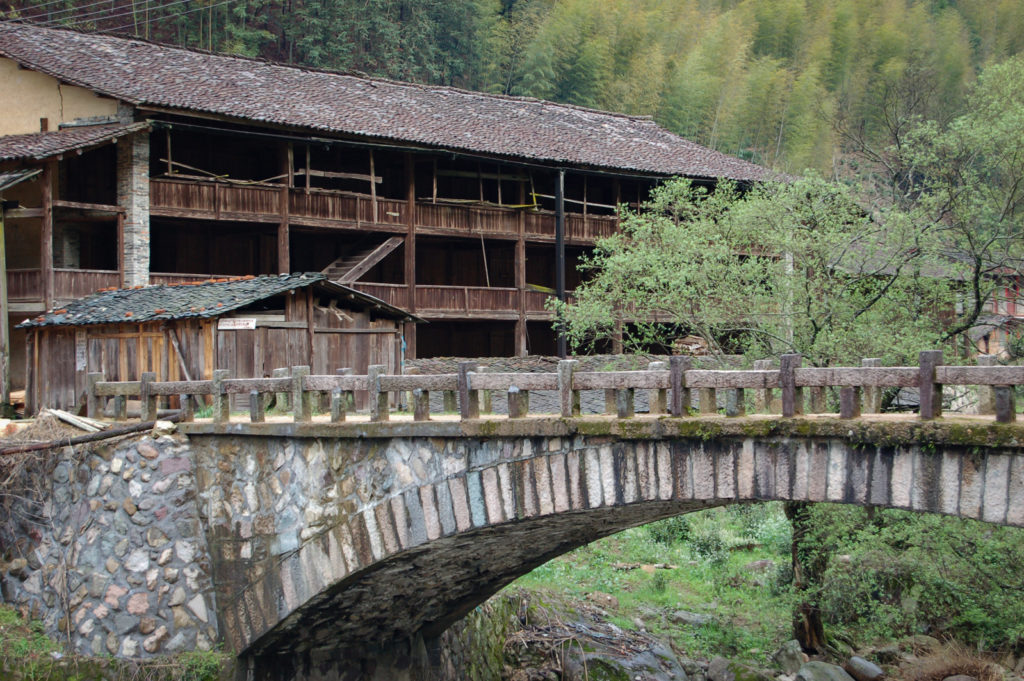
There is another, perhaps more colorful, story of black tea’s genesis that comes from the local lore of Tong Mu Village in Wu Yi Shan. The Jiang family, of which Seven Cups’ Lapsang Souchong producer hails, has a history of 24th generation in Tong Mu Village and claims the honor of resourcefully inventing black tea after disaster struck the tea crop of the village.
Tong Mu village in Wu Yi Shan lies in a geographical gateway, connecting China’s southeast coast to its central interior. One spring in the mid 16th century, Tong Mu village found itself in the path of a moving army. With soldiers occupying their buildings, the village’s peasant farmers were cut off from processing a freshly plucked crop of tea. As far as the soldiers were concerned, a pile of soft tea leaves made a nice bed while they were in quarter. In the course of a week, the army moved on, leaving behind piles of dark tea leaves, twisted and blackened with bruising. The weight of the solders and the heat of their bodies coupled with the heat of natural fermentation caused by pressure, heat, and moisture, caused the tea to change. The crop of green tea was effectively ruined, if not for a stroke of perseverance.
Other Historical Points of Confusion Around Black Tea
Allegedly, it was the one of the Jiang family’s great ancestors who demanded the tea be dried and sent to market anyway. With astonishment, foreign merchants took to this radically different kind of tea, not only buying out the entire crop, but sending a payment for the whole of next year’s crop as well. There is some confusion about the details of this story, and some say these events couldn’t have taken place until the Tai Ping revolt in between 1850 and 1860, when soldiers invaded the Wu Yi Mountains and Tong Mu. Whether or not this story is true, it sets an accurate picture of the culture in China’s black tea production. Considered to be something of unorthodox taste in China’s domestic market, black tea has solely been pursued as a profitable export. Ironically stranger in its own home, this was the tea that was to conqueror the world.
The Naming of Black Tea
When the Dutch East India Company first carried tea as merchant cargo in 1610, they had bought their tea at Indonesian markets where it had been exported from China. At that time, the southeast coast of China was kept unpopulated by government force and there were no harbors open for trade. With the coming of the Qing Dynasty, the closed coastline policy was dissolved by 1684, tea became available to western merchants in unprecedented volume from markets in Fujian. It was the Fukinese tongue that named black tea for the rest of the world. “Lei Xun” or “Smoke scented” in Fuzhuou dialect, is considered by many to be the etymological origins of the word “Lapsang” – as in “Lapsang Souchong.” “Bohea” (pronounced “Boo Hee”) is derived from the Fukienese pronunciation of “Wu Yi.” In that day, the Wu Yi mountains were the only producer of black tea. Thus the name “Wu Yi” or “Bohea” was synonymous with black tea. This name for black tea persisted in use, even when black tea was being produced elsewhere.
The Production of Black Tea
The evolution of the tea making process of black tea is not clear, but there are some similarities to the oolong making process that was evolving in the lower mountain areas of Wu Yi Shan. It is likely in the beginning Tong Mu tea was closer to oolong, evolving from botched attempts at making green tea. However, the distinct qualities of each region brought about divergent styles of tea making.
Weather conditions are very different between Tong Mu and Wu Yi Shan. At a relatively higher elevation, Tong Mu’s winter is colder and longer. Tea leaves grown here are smaller, but still can stand up to a lot of processing without crumbling. Additionally, the long winter encourages a concentration of amino acids in Tong Mu’s tea, which in combination with the regions mineral rich soil, is responsible for a characteristic sweetness. Even after surviving a lot of exposure to smoke, one can still taste the sweet, fruity character of tea from Tong Mu – a quality that is lost with other leaves that come from other places.
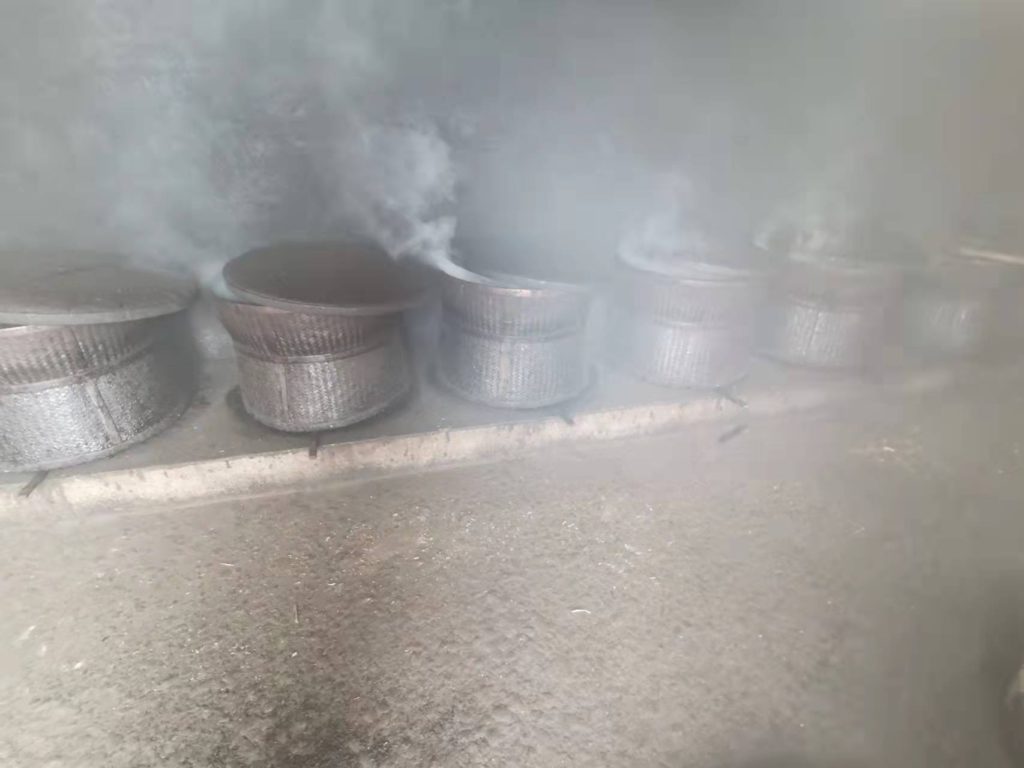
The seasoning of tea by smoke is in its self, a practice brought about by the special circumstances of Tong Mu village. Tong Mu differs from lower Wu Yi Shan not only in ecosystem, but also in economics. Being much poorer and growing more pine than bamboo, tea makers in Tong Mu burned raw timber as a heat source, rather than using the more expensive bamboo charcoal that was commonly used by other tea producing regions.
How Black Tea Gets Produced
The production of black tea, like oolong, begins with the withering of fresh leaves. After withering, the tea is manipulated in some way to cause oxidation of the leaf from bruising. In the case of Zhen Shan Xiao Zhong or Lapsang Souchong, this is done by heating the leaves to 60°C to 70°C, stirring them every twenty minutes, and when the leaves are pliable, they are rolled and shaped and then put into wooden boxes to oxidize. When the leaves have changed to a copper color and the veins are red, they are fried in a very hot flat pan at about 200°C for 2 or 3 minutes, and then rolled and shaped again for 5 to 7 minutes until they are tightened. The tea is then put on bamboo baskets and slow roasted over the pine fire heated earthen ovens for 8 to 10 hours.
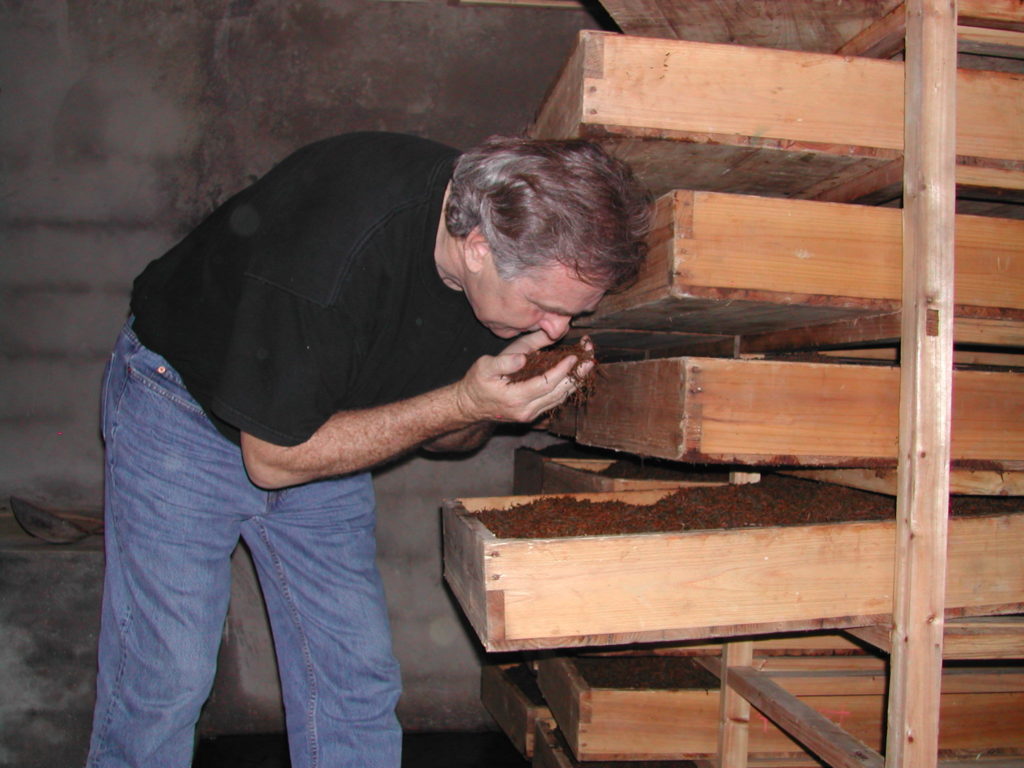
It is not correct to think the first black tea, the smokey Zhen Shan Xiao Zhong, is dried over an open fire. Their smokey quality is derived from the earthen ovens of Tong Mu village. The oven’s design warms the ground of an enclosed space that is floored with rocks to provide radiant heat. These ovens leak a certain amount of smoke, the best of these ovens leaking the least amount of smoke. But even the really well made ovens cannot contain the smell from the pine fires heating them. Inside the ovens, the racks made to hold the trays of tea have turned black with smoke. The smell of the building is enough to make the tea stored there smoky tasting, but when a stronger smoke flavor is sought, ovens are adjusted to leak more smoke. The ovens are large compared to the small bamboo charcoal roasting baskets used for making oolong, so much so that three story tea making houses have been built upon these ovens.
